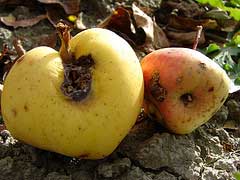What beast are we looking for?

First, it's important to understand what we mean by "enzyme kinetics". As you know, an enzyme is a molecule, which facilitates your reaction, but is not consumed in the reaction. For example, the enzyme o-diphenol oxidase catalyzes the oxidation of phenols, found in apples for example, a dark colored products. So in this reaction, phenols are combined with oxygen, which forms a dark color product, and the o-diphenyl oxidase is not consumed in the reaction, but goes on its merry way to convert more phenols.
However, o-diphenol oxidase is a bit of a mouthful. Although we will come back to this enzyme at the end of the module, for right now. We'll talk about an easier enzyme known as chocolatase. The function of this admittedly fictional enzyme is to take perfectly good chocolate and mash it up into a mushy goop.
 So, quick review:
So, quick review:
enzyme = chocolatase
substrate = chocolate
When we study the kinetics of the chocolatase enzyme, the important question is, how fast is chocolate turned into a mushy goop. In enzyme kinetics models, the speed of product production is called "V", for velocity. Everyone admits that velocity is not a very good term, but it has historical roots, so "V" it is.
Specifically, what we want to know is, as the amount of chocolate in the environment changes, how does the rate of goop production change?
If we want to graph the relationship between the amount of chocolate in the environment and the rate of goop production, how should the axes of the graph be labeled? You don't need to know the units at this point, just what goes on the x and y axes.
(To make this problem interactive, turn on javascript!)
- I need a hint ... : think of yourself as an experimenter. Whatever quantity you are able to control belongs on the x-axis.
- I need another hint ... : Which can you control directly, the amount of chocolate available, or the rate of goop production?
I think I have the answer: x-axis is the amount of substrate, y-axis is V velocity, or rate, of the reaction
Copyright University of Maryland, 2007
You may link to this site for educational purposes.
Please do not copy without permission
requests/questions/feedback email: mathbench@umd.edu